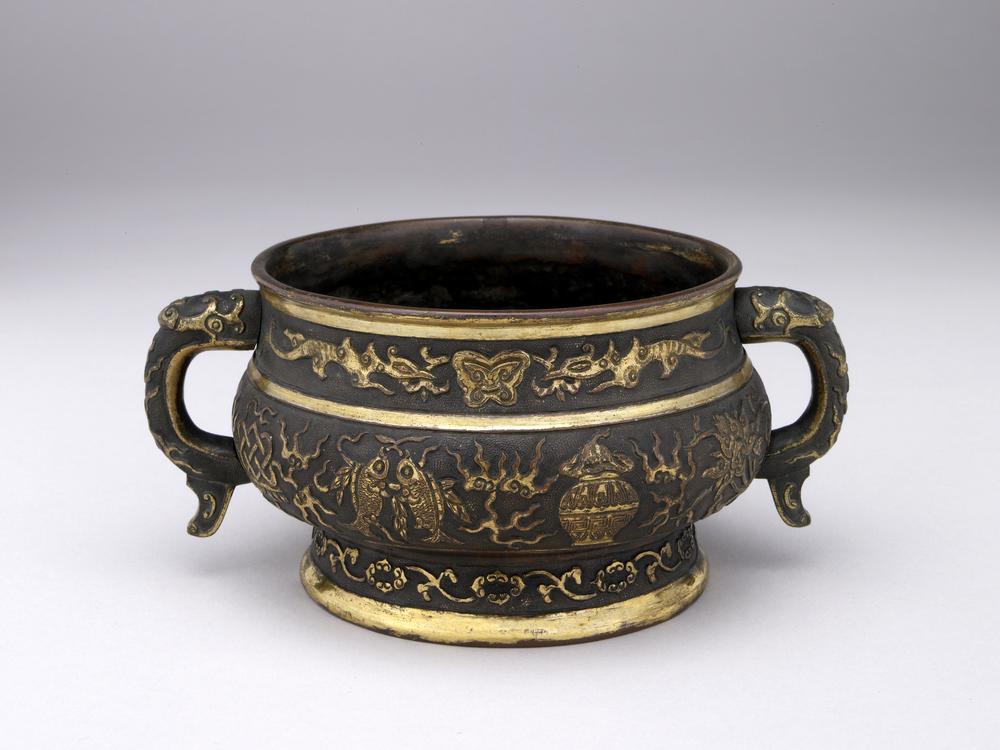Period:Unknown Production date:2008
Materials:paper, silk (mounting),
Technique:painted
Subjects:landscape
Dimensions:Height: 136 centimetres (image) Height: 215.50 centimetres (mount inc. hanging cord) Width: 68 centimetres (image) Width: 94.50 centimetres (mount inc. rollers)
Description:
Hanging scroll painted in ink and colours (including smalt, sienna, azurite and verdigris) on xuan paper, the final backing on Japanese paper; plain white mounting silk. Landscape, close-up view looking down into a narrow gorge, emphasizing the towering cliffs. Signed and inscribed; three seals.
IMG
![图片[1]-hanging scroll; painting BM-2014-3002.1-China Archive](https://chinaarchive.net/Unknown/Paintings/Flowing_Water_Tinling_Jade.jpg)
Comments:For this work Hsu Kuo-huang was inspired by the landscape near two famous scenic spots on the Central Cross-Island Highway—Taroko Gorge (太魯閣) and Tien-hsiang (天祥). In addition to ink, he used smalt for the blue of the cliffs, and sienna, azurite, and verdigris green for the rocks at the bottom of the gorge.The title of the work is a Chinese idiom that refers to the sound water makes when gurgling over rocks and stones. Chinese liken the sound to tinkling jade, in reference to the noise that jade plaques make when lightly touching one another. In ancient China, elite men wore long, ornamental strings of jade pendants hanging from their waist, and when they walked, the jades brushed each other, creating a delicate sound.In ‘Flowing Water Tinkling Jade’, hooked strokes, axe-cuts, rubbed strokes and more are employed. Hsu has carefully textured the surfaces of the craggy, jagged rocks and cliff faces with skeins of ink lines and dots that depict a rough surface, but his handling of the brush—the kinaesthetic quality of the ink lines—animates the mountains with”qi”—the Chinese understanding of mountains and rocks as being forms of “manifested energy.” The painting is an example of Hsu Kuo-huang’s signature style that builds on traditional “literati” brush-painting techniques that he updates by personal innovations, including a fresh use of perspective.His work employs many traditional brush techniques, including strokes learned from his mastery of calligraphy. His signature style builds on traditional ‘literati’ brush-painting techniques updated by personal innovations, including a fresh use of perspective. His work is typically based on close observation of natural scenery, sketched ‘en plein air’, then painted in his studio, distilling the scenery to its essential and most striking qualities. Nonetheless, the works usually retain a clear connection with a specific, identifiable site.
Materials:paper, silk (mounting),
Technique:painted
Subjects:landscape
Dimensions:Height: 136 centimetres (image) Height: 215.50 centimetres (mount inc. hanging cord) Width: 68 centimetres (image) Width: 94.50 centimetres (mount inc. rollers)
Description:
Hanging scroll painted in ink and colours (including smalt, sienna, azurite and verdigris) on xuan paper, the final backing on Japanese paper; plain white mounting silk. Landscape, close-up view looking down into a narrow gorge, emphasizing the towering cliffs. Signed and inscribed; three seals.
IMG
![图片[1]-hanging scroll; painting BM-2014-3002.1-China Archive](https://chinaarchive.net/Unknown/Paintings/Flowing_Water_Tinling_Jade.jpg)
Comments:For this work Hsu Kuo-huang was inspired by the landscape near two famous scenic spots on the Central Cross-Island Highway—Taroko Gorge (太魯閣) and Tien-hsiang (天祥). In addition to ink, he used smalt for the blue of the cliffs, and sienna, azurite, and verdigris green for the rocks at the bottom of the gorge.The title of the work is a Chinese idiom that refers to the sound water makes when gurgling over rocks and stones. Chinese liken the sound to tinkling jade, in reference to the noise that jade plaques make when lightly touching one another. In ancient China, elite men wore long, ornamental strings of jade pendants hanging from their waist, and when they walked, the jades brushed each other, creating a delicate sound.In ‘Flowing Water Tinkling Jade’, hooked strokes, axe-cuts, rubbed strokes and more are employed. Hsu has carefully textured the surfaces of the craggy, jagged rocks and cliff faces with skeins of ink lines and dots that depict a rough surface, but his handling of the brush—the kinaesthetic quality of the ink lines—animates the mountains with”qi”—the Chinese understanding of mountains and rocks as being forms of “manifested energy.” The painting is an example of Hsu Kuo-huang’s signature style that builds on traditional “literati” brush-painting techniques that he updates by personal innovations, including a fresh use of perspective.His work employs many traditional brush techniques, including strokes learned from his mastery of calligraphy. His signature style builds on traditional ‘literati’ brush-painting techniques updated by personal innovations, including a fresh use of perspective. His work is typically based on close observation of natural scenery, sketched ‘en plein air’, then painted in his studio, distilling the scenery to its essential and most striking qualities. Nonetheless, the works usually retain a clear connection with a specific, identifiable site.
© Copyright
The copyright of the article belongs to the author, please keep the original link for reprinting.
THE END
![[Qing Dynasty] British female painter—Elizabeth Keith, using woodblock prints to record China from the late Qing Dynasty to the early Republic of China—1915-China Archive](https://chinaarchive.net/wp-content/uploads/2022/11/image-191x300.png)




